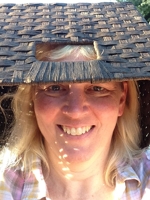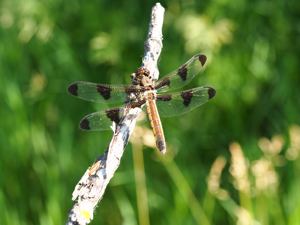Poems by Martha Nance
Archives: by Issue | by Author Name

Flowering Dragonflies
by Martha Nance
From Canary Summer 2021
Martha's dragonfly pond , across the street, is in the Riley-Purgatory-Bluff Creek watershed, but the back door of her prairie home looks right over the lower Minnesota River watershed, where the neck-loving deer flies are definitely above average.

There are said to be upwards of 5,000 species of dragonflies in the world today, and 140 in Minnesota, where I live. Over 25 species live in, or have visited, My Yard on the bluffs near the Minnesota River in the last five years, soaring and hovering into my consciousness each summer.
One of the first things I noticed about the dragonflies in My Yard, once I started noticing anything at all about them other than “look, a big bug!”, is that certain dragonflies appear at certain times in the summer, and then disappear after a few weeks. So, the Dot-Tailed Whitefaces that are all over the field in June, are entirely gone by August, but the first meadow hawks appear in July and die out in October.
As I have spent time over the last few years in my front yard and down by the pond a quarter mile away photographing the colorful and skilled aviators who think of my neighborhood as theirs, I have observed, wondered, learned, and marveled at many things about them. The ancestors of today’s dragonflies came into existence 350 million years ago, and survived the Permian, Triassic, and Cretaceous extinction events of 250, 120, and 65 million years ago. If there is a new generation of dragonflies each year (which is the case for many species), that is a lot of generations in which to refine, well, everything: vision, flight, reproductive strategies, feeding behavior, you name it. After a lifetime harboring an anthropocentric view of evolution drummed into me (by whom? Church, certainly, except I never attended one. Books I read as a young child? Or was it something less intentional, not a premeditated brainwashing but simply the excitement about the discoveries of “the earliest humans” in Africa as I was growing up, that reinforced a sense that the development of humans was the goal, the pinnacle of evolution?) I have finally grasped that the dragonflies of today reflect the culmination of 350 million years of evolution’s work. In contrast, if we really push it, we can find human ancestors dating back seven million years. At 20 years per generation, that adds up to 350 thousand human generations, 1000-fold fewer than the generations spent perfecting dragonflies!
What an amazing privilege it is to see in the skimmers and dashers and club tails and darners of My Yard, the products of so many years of fine-tuning. I see eyes with almost 360-degree vision, with 30,000 separate lenses tuned to distinguish 20 or more different colors of light. I see four corrugated, strutted wings, moving independently using a variety of stroke patterns depending on what the situation calls for—a rapid burst to grab an insect for lunch, a heavily-laden flight with mate in tow, or a multi-thousand mild migration (yes, the 1.5-inch-long Wandering Skimmer crosses the Indian Ocean from India to east Africa and can fly over 4000 miles, and the Green Darners in My Yard fly hundreds of miles along the Mississippi River each fall in swarms large enough to be seen on radar). I see soaring, hovering, perching, brief sorties, guarding of territories, curious and sometimes aggressive behaviors.
I spent three years photographing dragonflies without leaving the confines of the field and garden in my front yard, except for straying into the next-door neighbor’s field that is contiguous with ours. But one day, I wandered down to the pond, and found a whole different dragonfly world there.
Dragonflies spend the vast majority of their lives in the water, their larval forms striking terror into the minds of any other larval insects, and even small fish, that might share their space. They are fearsome underwater predators, with an extensible prehensile jaw that rivals the tongue of an amphibian in speed and accuracy when grabbing prey. I have not gotten so obsessed as to immerse myself or my camera into the water to document their underwater lives, but I admit to knowing that jaw-action videos are available on You Tube for those who are interested.
What I have watched and found awe-inspiring, like watching a caterpillar wrap itself into a pupa and later emerge as a butterfly, is the moment that a brave dragonfly takes its first steps out of the water (which are in fact also its last, as adult dragonflies do not walk!), breathes air, climbs up and attaches to a nearby reed or blade of grass, emerges from its old half-size, compressed, brown, silt-covered shell into a four-winged, multicolored, huge-eyed insect, shakes off the wet, and takes flight for the first time. This whole process takes an hour or two. As far as I know, no other human in my neighborhood has kneeled in the muck to watch this remarkable but commonplace event take place; it took me almost 60 years to get to it.
It is hard not to notice that our neighborhood pond is fragile. A dry summer or lack of snow leads to a lower water level. The edge of the pond retreats, and one wonders if it will dry up completely in a few years. The first year I spent time at the pond, marveling at the many exuviae (discarded larval skins) attached to the many reeds at its edge, another visitor, a muskrat, moved in and destroyed all of the reeds on my end of the pond. A beaver family is hard at work destroying the habitat that likely attracted them to the pond, taking out trees one by one. The community mosquito patrol bombs any open areas of water while we are at work in the summer. And a new human neighbor, in defiance of toothless neighborhood covenants, has been strafing the pond this winter with his snowmobile, to be followed next summer, no doubt, by a jet ski. I’m not sure that the pond that attracted me to this neighborhood 25 years ago will survive.
But I think I have an answer to one of my many questions: why do dragonflies bother having an airborne life stage? They have a very successful first stage, as skilled underwater predators. Why not stay underwater for that final, reproductive, stage? I think the answer is that the dragonflies I see doing racetracks over my field, darting up from garden stakes to grab a fly and re-perch, and chasing each other over the pond, are the dragonfly equivalent of a flower. The milkweed plants out in the field, and the tithonias I grow, spend most of their time as ignorable but increasingly large green structures, until magically their flowers appear, which attract bees and monarchs from miles around, and pretty soon seeds for the next generation appear, and in the case of the milkweed, fly off in all directions.
Dragonflies do not require bees and monarchs like the flowering plants do, but they attract each other with their bright colors and flight skills. Like the flowers in my yard, different damsels and dragons appear at different times during the summer—I no more expect to see a Four-Spotted Skimmer or Horned Clubtail bloom in August than a daffodil or a lilac. And importantly, if my pond dries up, has no more mosquitoes to eat, no reeds to grab, and no trees to provide shade, my Cherry-Faced Meadowhawks and Blue Dashers will fly to the next pond, at least some of them will, and the Canada Darners, Black Saddlebags, and Wandering Gliders are just passing through anyway, on their way to wherever the food is most dense, at the beginning of the summer, and to warmer ponds at the end.
As long as there are water, air, and other flying insects, dragonflies will survive. If global warming makes the tropics too hot, melts the glaciers, and makes parts of the world inhospitable for humans, flowering dragonflies will find new ponds and streams to give them life. No humans required.
© Martha Nance